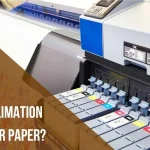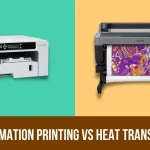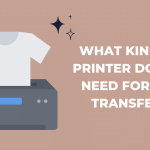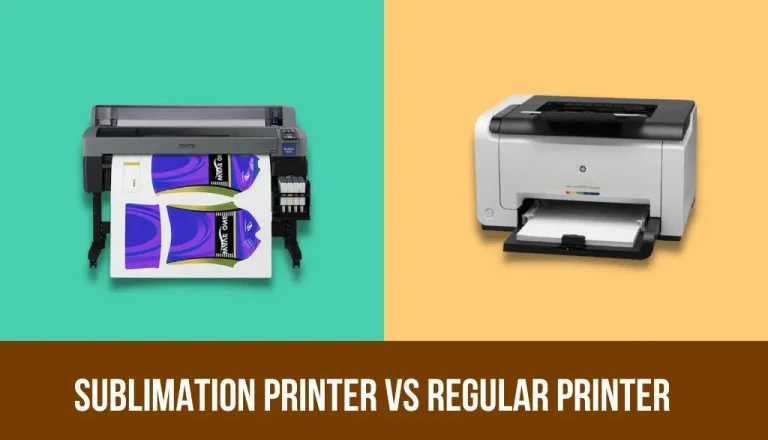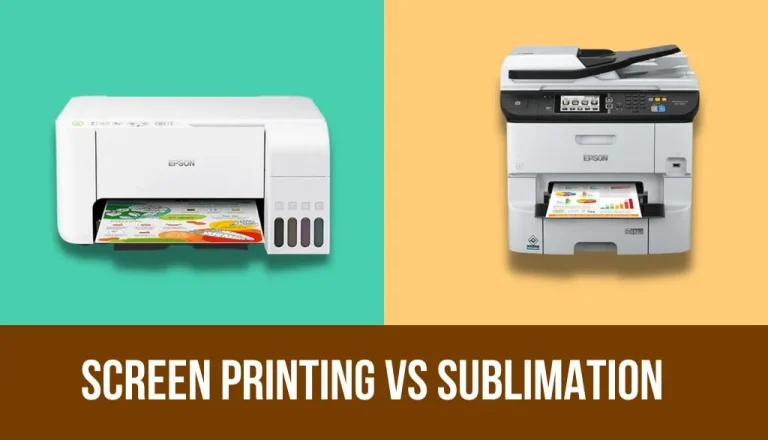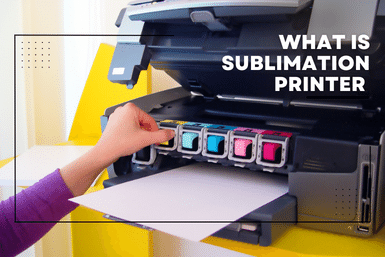Sublimation Paper vs Transfer Paper (Get the Best Transfer)
Sublimation printing is the most effective technique used to print on a wide variety of materials. With this method, the ink is converted into a gas and then comes out of the paper as vapor.
Sublimation printers can produce high-quality prints that are permanent. Today, We will discuss about Sublimation Paper vs Transfer Paper.
Types of Paper

There are different kinds of papers available that can be used for sublimation printing. These are transfer paper, hot-melt paper, and regular paper. But when it comes to transferring an image onto a surface, printing paper is classified into two main types:
- Transfer paper
- Sublimation paper
Sublimation Paper vs Transfer Paper – Which Is Better?
When you’re trying to decide between a sublimation paper and a transfer paper, it can be difficult to know which is best.
Both are used for sublimation printing, but which one is better? What are the benefits of each? What are the differences between the two?
The answer to all of these questions is that it depends on what type of print job you’re doing.
The most important thing to keep in mind is that both papers are designed to be used for sublimation printing. There are a few key differences between the two, though.
Transfer paper

Transfer paper is used with sublimation ink, pigment ink, solvent ink, or other ink types for prints, photographs, and artwork. This type of paper has a very thin and transparent film. But heat transfer paper is usually used to transfer images only to fabrics such as cotton and polyester.
There are two types of heat transfer paper are:
- Transparent Heat Transfer Paper
- White Heat Transfer Paper
Clear heat transfer paper is used to print on light fabrics such as white. On the other hand, white heat transfer paper for dark fabrics such as blue, black, magenta, red and etc.

Sublimation paper
Sublimation paper is a special kind of paper and is a bit thicker than transfer paper. They are generally used for printing on fabrics, banners, mouse pads, mouse cases, and hard surfaces such as metal, glass, ceramic, and aluminum plates.
There are nine different types of sublimation transfer papers as follows:
- FU-A sublimation paper
- FU-B sublimation paper
- FU-C sublimation paper
- FU-L and FU-Q sublimation paper
- FU-MS and FU-KH sublimation paper
- FU-W and FU-Z sublimation paper
- Large format sublimation paper
- Reggiani sublimation paper
- FTB sublimation paper
Each sublimation paper has different properties and uses. FU-A sublimation paper is the most suitable for printing on all kinds of fabrics. It doesn’t leave any residue on the surface after it is printed.
Key Differences between Sublimation Paper and Transfer Paper
| Feature | Sublimation Paper | Transfer Paper |
|---|---|---|
| Ink | Sublimation ink | Heat transfer vinyl (HTV) |
| Transfer process | Ink turns from solid to gas and bonds to fabric | Design is transferred to vinyl and then bonded to fabric |
| Durability | Very durable | Less durable than sublimation paper |
| Feel | Soft and smooth | Slightly textured |
| Colors | Wide range of colors available | Limited range of colors available |
| Price | More expensive than transfer paper | Less expensive than sublimation paper |
Advantages & Disadvantages
Here we will present some of the reasons why we prefer one over the other.
Merits of heat transfer paper
- Easier to use than a sublimation paper.
- Allows for full-color designs with a single layer.
- Less likely to produce mistakes.

Demerits of heat transfer paper
- Images may fade or peel over time.
- Do not print as vibrant as the sublimation.
Merits of sublimation paper
- Print high-quality, full-color images.
- Permanent image transfer.

Demerits of sublimation paper
- A bit tricky to use.
- A completely flat surface is required.
- In the presence of moisture, the results may not be as you want.
Nowadays, people are more aware of the importance of saving the environment, so they are trying to use eco-friendly products as much as possible. One of the most popular eco-friendly products is transfer paper, and recyclable.
So, which type of printing paper is best for you?
A sublimation paper is designed for permanence; it will produce a high-quality image. The paper itself is usually coated with a light-reflective coating to increase visibility. For a permanent image that will not fade or peel over time, then a sublimation paper is best.
However, a transfer paper has a glossy finish and is easier to use and more forgiving of mistakes than sublimation paper.
Frequently Asked Questions: (FAQs)
Is transfer paper the same as sublimation paper?
No. The transfer paper is not the same as the sublimation paper. Transfer paper and sublimation paper are two different types of paper that are used for transferring images and graphics on different substrates.
Sublimation paper uses a sublimation printer and sublimation ink to print images whereas transfer paper uses an inkjet printer for printing purposes.
Can you use sublimation paper in any printer?
Sublimation paper is made specifically for sublimation printers and cannot be used in any other printer.
Can I use sublimation paper for heat transfer?
Sublimation transfer paper is not designed to work well for heat transfer. It is used primarily for photo printing by using a special dye.
So, sublimation paper is not recommended for heat transfer because it doesn’t perform as well as other types of transfer papers. We recommend you use only transfer paper for heat transfer projects.
Conclusion
For something with a longer lifespan than standard transfer papers, then you should check out the sublimation paper. While transfer papers are more flexible and can be used with a wider variety of fabric types, sublimation papers offer a more lasting and smoother finish.
However, sublimation papers are the only kind of paper that will not discolor or fade. This is because the ink used in this type of paper does not stick to the surface of the material; rather, the ink goes straight into the fibers of the paper.

